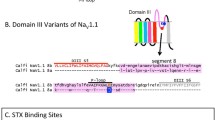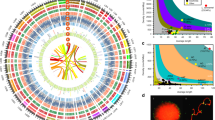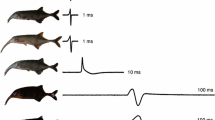Abstract
The softshell clam, Mya arenaria, is a commercially important bivalve with wide latitudinal distribution in North America. Populations of clams with a history of repeated exposure to toxic Alexandrium spp. have developed a natural resistance to the paralytic shellfish toxins (PSTs) produced by these algae. An association between PST resistance in individual clams and a single mutation in the saxitoxin (STX) binding region of the α-subunit of the voltage-gated sodium (Na+) channel gene was previously identified. Here we establish that more than one mutation associated with nerve resistance to STX occurred at this locus. Both cDNA from mRNA and genomic DNA sequences from individual clams are identical demonstrating that both alleles are expressed simultaneously. In addition, one resistant allele per individual is sufficient to confer neural resistance to STX even though heterozygous individuals show an intermediate level of resistance to STX in in vitro nerve trunk assays.

Similar content being viewed by others
References
Anderson PAV (1987) Properties and pharmacology of a TTX-insensitive Na+ current in neurons of the jellyfish Cyanea capillata. J Exp Biol 133:231–248
Anderson DM (1997) Bloom dynamics of toxic Alexandrium species in the northeast US Limnol Oceanogr 42:1009–1022
Anderson DM, Kulis DM, Doucette GJ, Gallagher JC, Balech E (1994) Biogeography of toxic dinoflagellates in the genus Alexandrium from the northeastern United States and Canada. Mar Biol 120:467–478
Anderson DM, Keafer BA, McGillicuddy DJ, Mickelson MJ, Keay KE, Libby SP, Manning JP, Mayo CA, Whittaker DK, Hickey JM, He R, Lynch DR, Smith KW (2005a) Initial observations of the 2005 Alexandrium fundyense bloom in southern New England: general patterns and mechanisms. Deep Sea Res II 52:2856–2876
Anderson PAV, Roberts-Misterly J, Greenberg RM (2005b) The evolution of voltage-gated sodium channels: were algal toxins involved? Harmful Algae 4:95–107
Backx PH, Yue DT, Lawrence JH, Marban E, Tomaselli GF (1992) Molecular localization of an ion-binding site within the pore of mammalian sodium channels. Science 257:248–251
Bricelj VM, MacQuarrie SP (2004) Can natural selection for resistance to paralytic shellfish poisoning toxins in softshell clam, Mya arenaria, populations occur during early life history stages? Harmful Algae 3:193–194
Bricelj VM, MacQuarrie SP, Twarog B, Trainer VL (2004) Characterization of sensitivity to PSP toxins in North American populations of the softshell clam Mya arenaria. In: Steidinger KA, Landsberg JH, Tomas CR, Vargo GA (eds) Harmful Algae 2002. Florida Fish and Wildlife Conservation Commission, Florida Institute of Oceanography and IOC of UNESCO, St. Petersberg, FL, pp 172–174
Bricelj VM, Connell L, Konoki K, MacQuarrie SP, Scheuer T, Catterall WA, Trainer VL (2005) Na+ channel mutation leading to saxitoxin resistance in clams increases risk of PSP. Nature 434:763–767
Brodie ED III, Brodie ED Jr (1999) Costs of exploiting poisonous prey: evolutionary trade-offs in a predator–prey arms race. Evolution 52:626–631
Caporale DA, Beal BF, Roxby R, Van Beneden RJ (1997) Population structure of Mya arenaria along the New England coastline. Mol Mar Biol Biotechnol 6:33–39
Catterall WA (1992) Cellular and molecular biology of voltage-gated sodium channels. Physiol Rev 72:S15–S48
Catterall WA (2000) From ionic currents to molecular mechanisms: the structure and function of voltage-gated sodium channels. Neuron 26:13–25
Coulondre C, Miller JH, Farabaugh PJ, Gilbert W (1978) Molecular basis of base substitution hotspots in Escherichia coli. Nature 274:775–780
Crawford DL, Powers DA (1992) Evolutionary adaptation to different thermal environments via transcriptional regulation. Mol Biol Evol 9:806–813
Crowe ML (2005) SeqDoC: rapid SNP and mutation detection by direct comparison of DNA sequence chromatograms. BMC Bioinformatics 6:133–144
Denac H, Mevissen M, Scholtysik G (2000) Structure, function and pharmacology of voltage-gated sodium channels. Naunyn Schmiedebergs Arch Pharmacol 362:453–479
Dillon RT Jr, Manzi JJ (1987) Hard clam, Mercenaria mercenaria, broodstocks: genetic drift and loss of rare alleles without reduction of heterozygosity. Aquaculture 60:99–105
Fallang A, Denholm I, Horsberg TE, Williamson MS (2005) Novel point mutation in the sodium channel gene of pyrethroid-resistant sea lice Lepeophtheirus salmonis (Crustacea: Copepoda). Dis Aquat Organ 65:129–136
Geffeney SL, Brodie ED Jr, Ruben PC, Brodie ED III (2002) Mechanisms of adaptation in a predator–prey arms race: TTX-resistant sodium channels. Science 297:1336–1339
Geffeney SL, Fujimoto E, Brodie ED III, Brodie ED Jr, Ruben PC (2005) Evolutionary diversification of TTX-resistant sodium channels in a predator–prey interaction. Nature (London) 434:759–763
Goldin AL, Barchi RL, Caldwell JH, Hofmann F, Howe JR, Hunter JC, Kallen RG, Mandel G, Meisler MH, Netter YB, Noda M, Tamkun MM, Waxman SG, Wood JN, Catterall WA (2000) Nomenclature of voltage gated sodium channels. Neuron 28:365–368
Hallegraeff GM (1993) A review of harmful algal blooms and their apparent global increase. Phycologia 32:79–99
Hanrahan CJ, Palladino MJ, Ganetzky B, Reenan RA (2000) RNA editing of the Drosophila para Na+ channel transcript: evolutionary conservation and developmental regulation. Genetics 155:1149–1160
He H, Chen AC, Davey RB, Ivie GW, George JE (1999) Identification of a point mutation in the para-type sodium channel gene from a pyrethroid-resistant cattle tick. Biochem Biophys Res Commun 261:558–561
Hilbish TJ, Koehn RK (1985) The physiological basis of natural selection at the Lap locus. Evolution 39:1302–1317
Kallen RG, Sheng Z-H, Yang J, Chen L, Rogart RB, Barchi RL (1990) Primary structure and expression of a sodium channel characteristic of denervated and immature rat skeletal muscle. Neuron 4:233–242
Koehn RK, Newell RIE, Immermann F (1980) Maintenance of an aminopeptidase allele frequency cline by natural selection. Proc Natl Acad Sci USA 77:5385–5389
MacQuarrie SP (2002) Inter-and intra-population variability in behavioral and physiological responses of the softshell clam Mya arenaria, to the PSP toxin-producing dinoflagellate, Alexandrium tamarense. M.S. Thesis, Department of Biology, Dalhousie University, Halifax, Nova Scotia, Canada
Maki H (2002) Origins of spontaneous mutations: specificity and directionality of base-substitution, frameshift and sequence-substitution mutagenesis. Annu Rev Genet 36:279–303
Martinez-Torres D, Chandre F, Williamson MS, Darriet F, Berge JB, Devonshire AL (1998) Molecular characterization of pyrethroid knockdown resistance (kdr) in the major malaria vector Anopheles gambiae s.s. Insect Mol Biol 7:179–184
Mee CJ, Pym ECG, Moffat KG, Baines RA (2004) Regulation of neuronal excitability through pumilio-dependent control of a sodium channel gene. J Neurosci 24:8695–8703
Mulligan HF (1974) Oceanographic factors associated with New England red tide blooms. In: LoCicero VR (ed) The first international conference on toxic dinoflagellate blooms. Massachusetts Science and Technology Foundation, Wakefield, pp 23–40
Narahashi T (1992) Overview of toxins and drugs as tools to study excitable membrane ion channels: II transmitter-activated channels. Methods Enzymol 207:643–658
Noda M, Suzuki H, Numa S, Stühmer W (1989) A single point mutation confers tetrodotoxin and saxitoxin insensitivity on the sodium channel II. FEBS Lett 259:213–216
Oshima Y (1995) Post-column derivatization HPLC methods for paralytic shellfish poisons. In: Hallegraeff GM, Anderson DM, Cembella AD (eds) Manual on Harmful Marine Microalgae, IOC Manuals and Guides. UNESCO 33:81–94
Palacios R, Armstrong DA, Orensanz J (2000) Fate and legacy of an invasion: extinct and extant populations of the soft-shelled clam (Mya arenaria) in Grays Harbor (Washington). Aquat Conserv Mar Freshw Ecosyst 10:279–303
Reenan RA (2001) The RNA world meets behavior: A->I (pre-mRNA editing in animals). Trends Genet 17:53–56
Satin J, Kyle JW, Chen M, Bell P, Cribbs LL, Fozzard HA, Rogart RB (1992) A mutant of TTX-resistant cardiac sodium channels with TTX-sensitive properties. Science 256:1202–1205
Schulte PM, Glemet HC, Fiebig AA, Powers DA (2000) Adaptive variation in lactate dehydrogenase-B gene expression: role of a stress-responsive regulatory element. Proc Natl Acad Sci USA 97:6597–6602
Shebley WH (1917) History of the introduction of food and game fishes into the waters of California. Calif Fish Game 3:3–12
Soderlund DM, Knipple DC (2003) The molecular biology of knockdown resistance to pyrethroid insecticides. Insect Biochem Mol Biol 33:563–569
Thompson JD, Higgins DG, Gibson TJ (1994) CLUSTAL W: improving the sensitivity of progressive multiple sequence alignment through sequence weighting, position-specific gap penalties and weight matrix choice. Nucleic Acids Res 22:4673–4680
Townsend CW (1893) Report of observations respecting the oyster resources and oyster fisheries of the Pacific Coast of the United States. In: United States Commission of Fish and Fisheries (ed) Report of The Commissioner for 1889 to 1891. Government Printing Office 1893, pp 343–372
Trainer VL, Eberhart B-TL, Wekell JC, Adams NG, Hanson L, Cox F, Dowell J (2003) Paralytic shellfish toxins in puget sound, Washington State. J Shellfish Res 22:213–223
Trimmer JS, Agnew WS (1989) Molecular diversity in voltage sensitive Na+ channels. Annu Rev Physiol 51:401–418
Twarog BM, Yamaguchi H (1974) Resistance to paralytic shellfish toxins in bivalve molluscs. In: LoCicero VR (eds) Proceedings of the first international conference on toxic dinoflagellate blooms. Massachusetts Science and Technology Foundation, Wakefield, pp 381–393
Twarog BM, Hidaka T, Yamaguchi H (1972) Resistance to tetrodotoxin and saxitoxin in nerves of bivalve molluscs: a possible correlation with paralytic shellfish poisoning. Toxicon 10:273–278
Vancouver G, Broughton WR (1802) A narrative or journal of a voyage of discovery to the North Pacific Ocean and round the world [microform]: performed in the years 1791, 1792, 1793, 1794 and 1795 by Captain George Vancouver and Lieutenant Broughton. Smeeton, J (printer), London
Vles F (1909) Monographie Sommaire de la Mye (Mya arenaria Linne). Mem Soc Zool Fr 22:90–142 (in French, English translation by USFWS, 1954)
Yang Z (1996) Among-site rate variation and its impact on phylogenetic analysis. Trends Ecol Evol 11:367–372
Acknowledgments
We thank the many individuals that assisted in field sample collection: B. Myrand (MAPAQ, Québec), D. Whitaker, J. Kennedy, L. Savina, S. Cunningham, D. Farbes (Massachusetts DMF), G. Gillespie (DFO BC), N. Adams and B. Bill (NOAA NWFSC). We also thank anonymous reviewers for detailed comments that have led to improvement of the final version of this manuscript. This work was supported by a NOAA-ECOHAB #NA 17OP1451 grant to LBC, VMB and V. Trainer. This is IMB/NRC publication #42562.
Author information
Authors and Affiliations
Corresponding author
Additional information
Communicated by R. J. Thompson, St. John's.
Rights and permissions
About this article
Cite this article
Connell, L.B., MacQuarrie, S.P., Twarog, B.M. et al. Population differences in nerve resistance to paralytic shellfish toxins in softshell clam, Mya arenaria, associated with sodium channel mutations. Mar Biol 150, 1227–1236 (2007). https://doi.org/10.1007/s00227-006-0432-z
Received:
Accepted:
Published:
Issue Date:
DOI: https://doi.org/10.1007/s00227-006-0432-z




